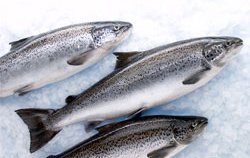A new project led by CSIRO is exploring the genes of farmed Atlantic salmon with a view to breeding fish resistant to an amoeba that attacks their gills.
The three-year project is one of several seeking ways to counter amoebic gill disease (AGD), a significant health problem for Tasmania's $150 million Atlantic salmon industry.
It is a project within the CSIRO Food Futures Flagship initiative and is funded by the Aquafin Cooperative Research Centre and the Australian Government through the Fisheries Research and Development Corporation and supported by industry.
This commercial application of research has the potential to transform Australia's salmon industry, according to Food Futures Flagship director, Dr Bruce Lee.
"The production of AGD-resistant fish will give consumers reliable access to top-quality salmon," Dr Lee says. "It will help make the industry more cost-competitive, yielding higher returns for salmon growers."
Fish infected with AGD are safe to eat, but they lose condition and must be bathed in freshwater to detach the amoeba from their gills. AGD costs the industry an estimated $15 million annually in treatment and lost productivity.
James Wynne, a PhD student with CSIRO and the School of Aquaculture, University of Tasmania, last year studied a group of genes known to influence the immune response in Atlantic salmon.
In this project he will further explore these and other genes with the aim of identifying variations in the genes of individual fish that make them more or less resistant to AGD.
A population of fish will be exposed to AGD in a purpose-built facility at the School of Aquaculture in Launceston. The genes of fish showing high and low resistance to AGD will then be examined for differences.
If gene forms relating to resistance can be identified, parent stock carrying these genes can be selected to breed new lines of AGD-resistant fish.
A second experiment, to be conducted by Dr Mathew Cook of CSIRO in collaboration with Norwegian colleagues, will use new genetic technology to identify the genes that are more, or less, active during the onset of AGD.
This work will point to the genes associated with resistance, as well as those active during infection, offering clues to alternative treatments.
This new genetic technology (termed DNA microarray) involves using a small glass slide that contains thousands of dots of DNA spotted on the surface, each one representing a particular gene. It offers the power to track differences in many thousands of genes at any one time with a minimal amount of samples.
Tasmanian salmon farmers have noted that individual fish in the same population show clear, measurable differences in amoeba infection. "If we can demonstrate that this is consistent and an inherited trait, we have a good chance of developing an amoeba-resistant line of salmon in Tasmania," project leader Dr Nick Elliott of CSIRO Marine Research says.
Industry partners agree that this would improve fish welfare through the summer months and reduce or eliminate the need to bathe the fish in freshwater. This in turn would enable Tasmanian salmon to be more cost competitive in the global market.
The project is one of 10 AGD-related projects in the Aquafin CRC Health Program. Others are investigating alternative treatments and vaccine development.
For more information contact: Dr Nick Elliott, CSIRO Marine Research: nick.elliott@csiro.au











